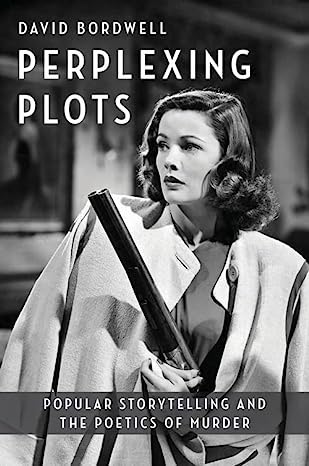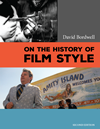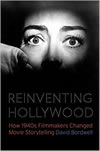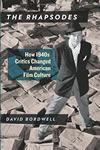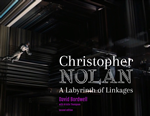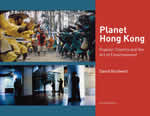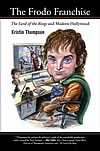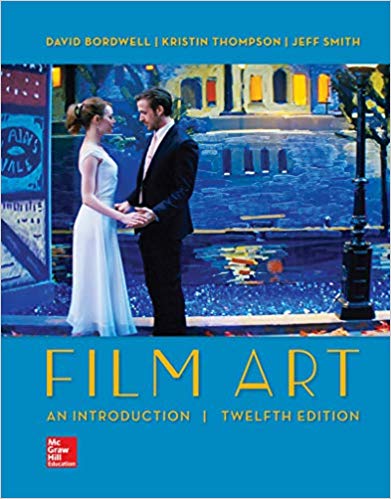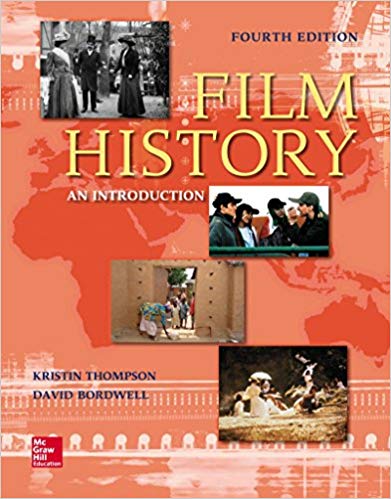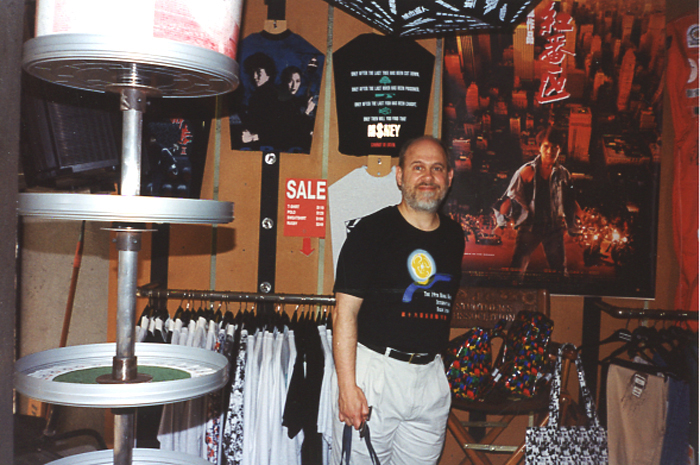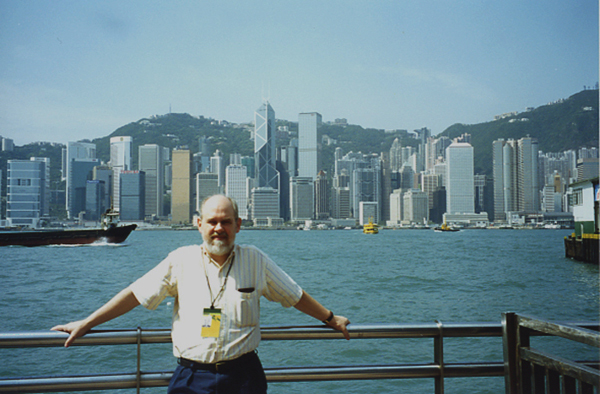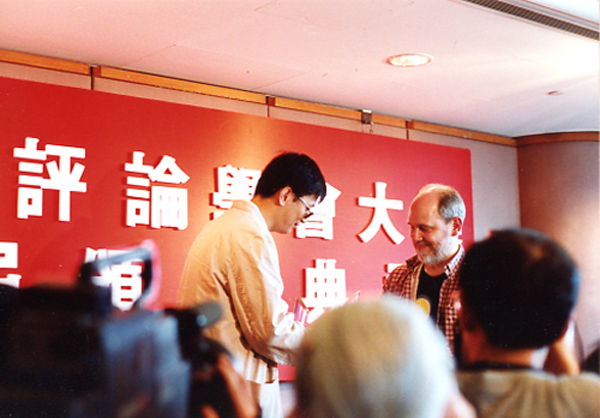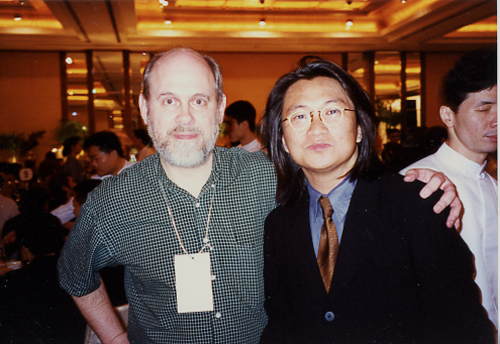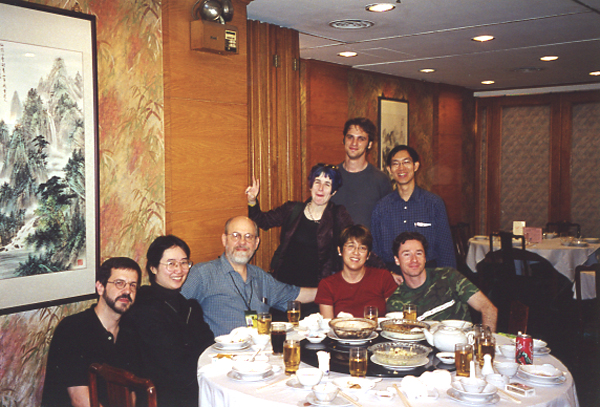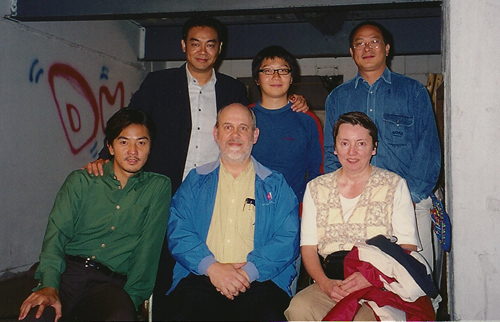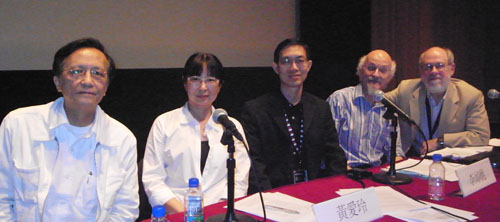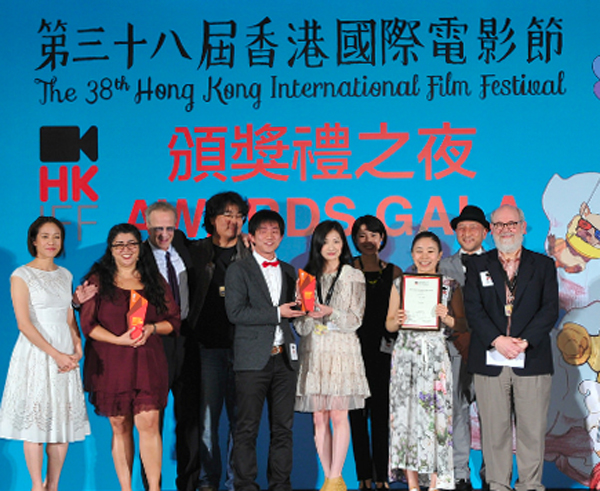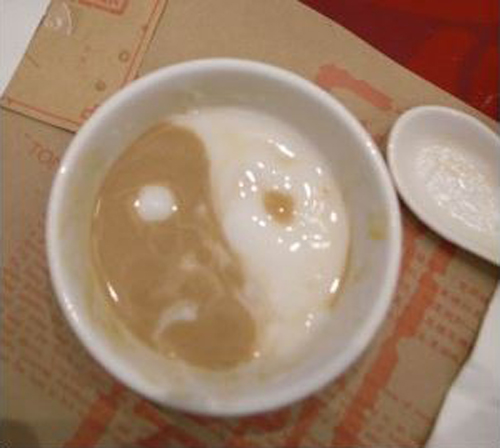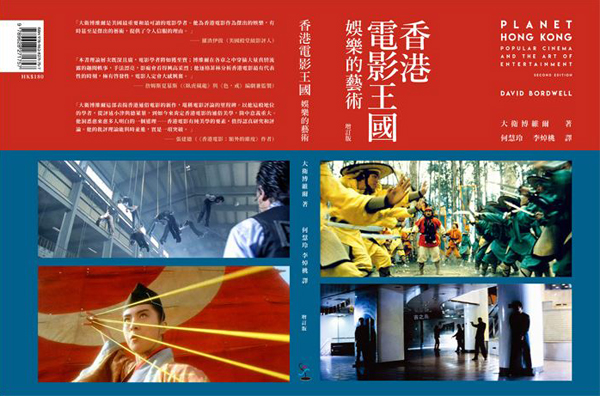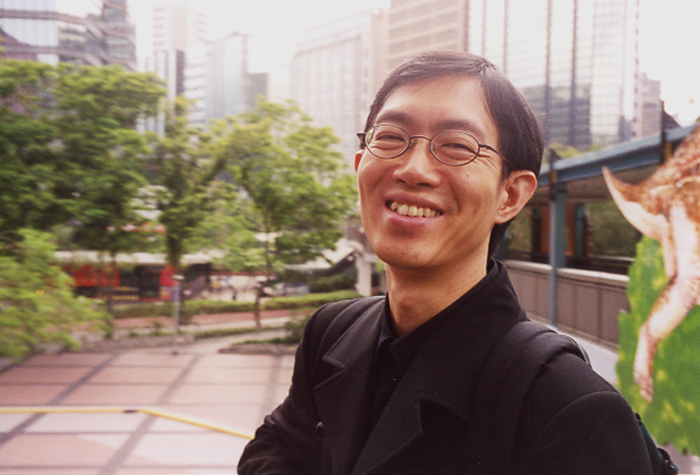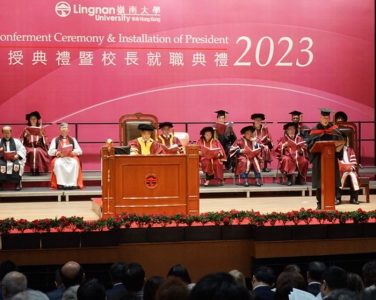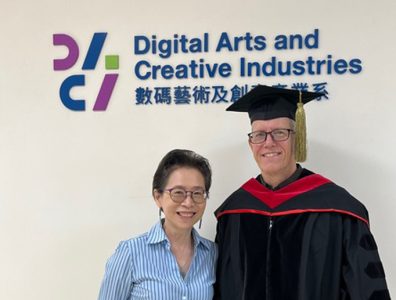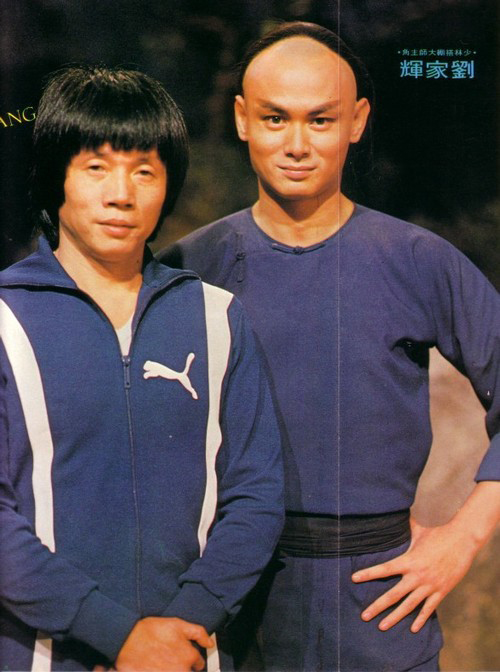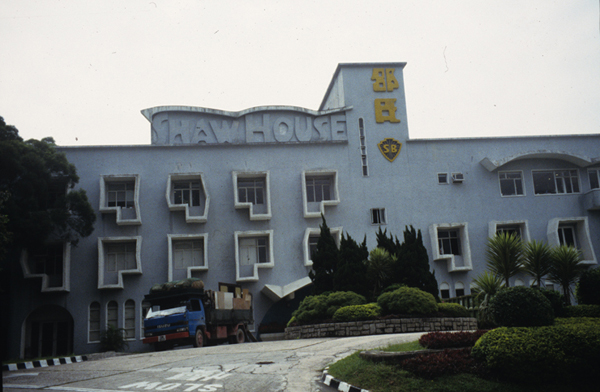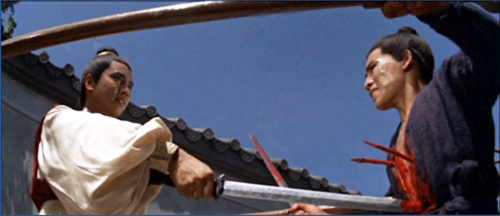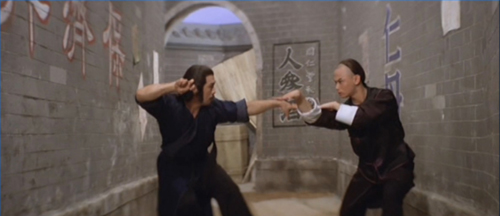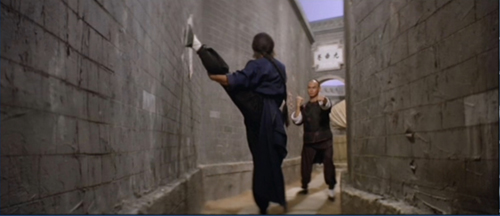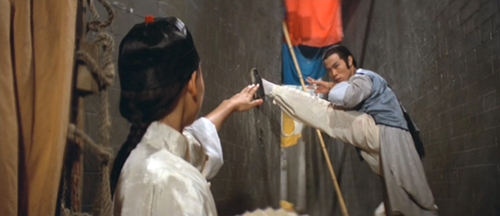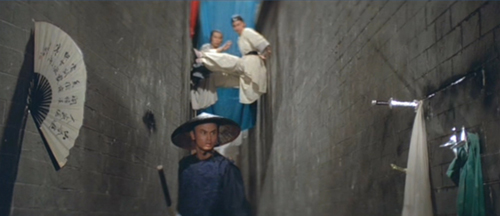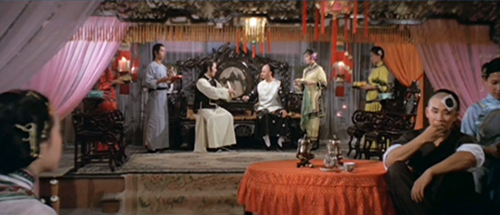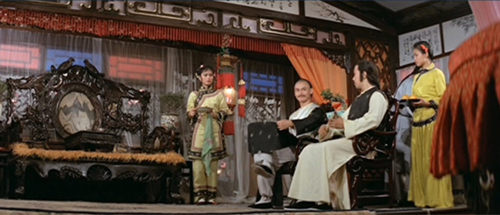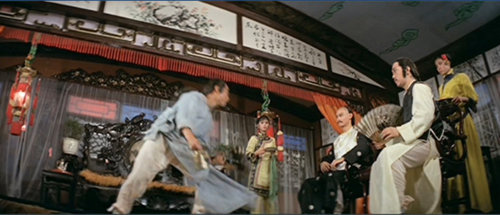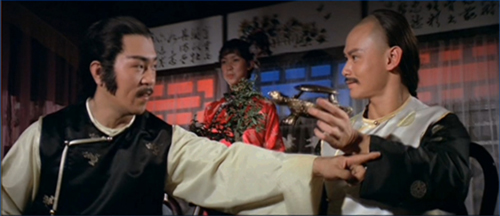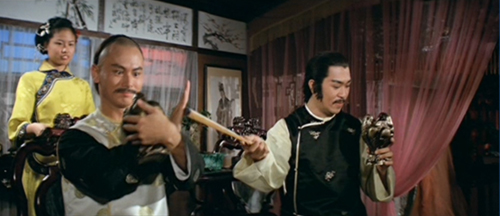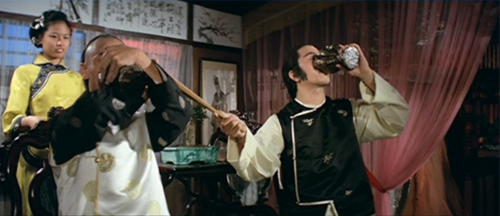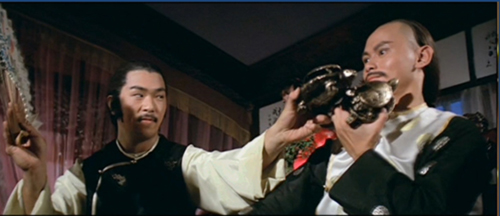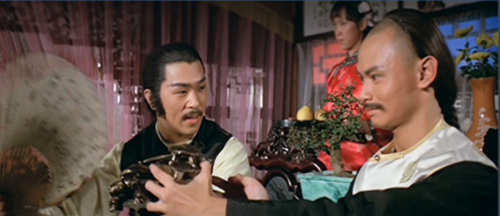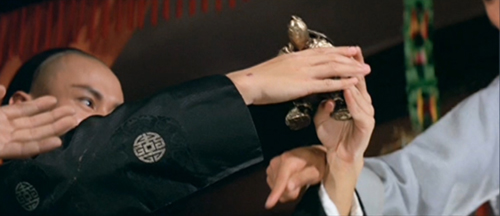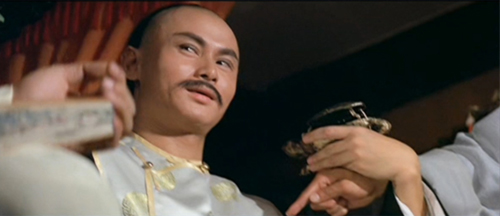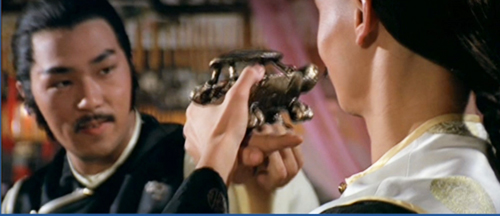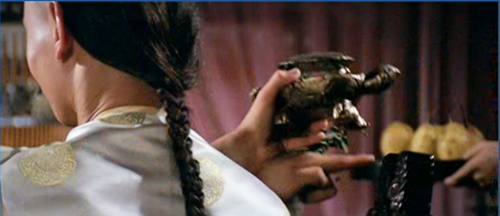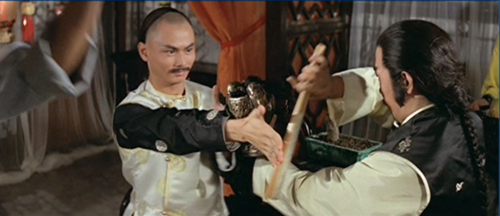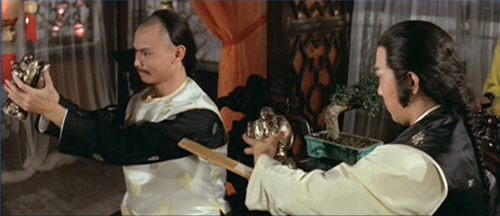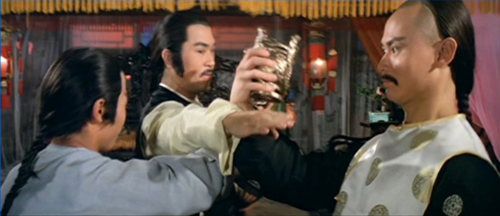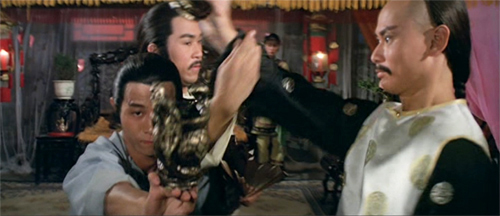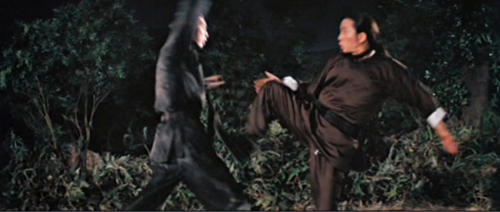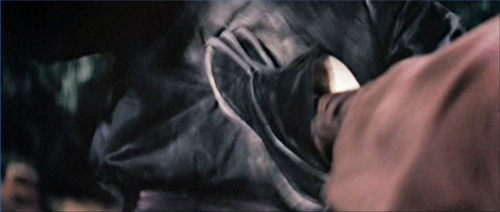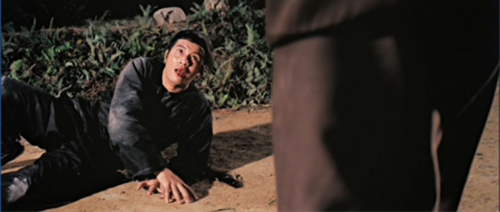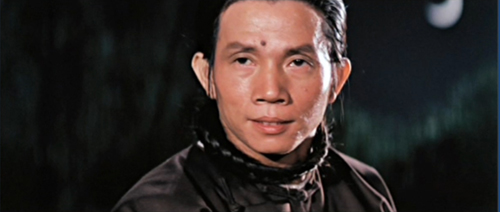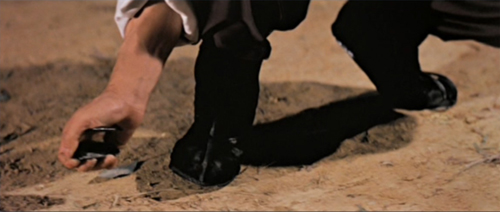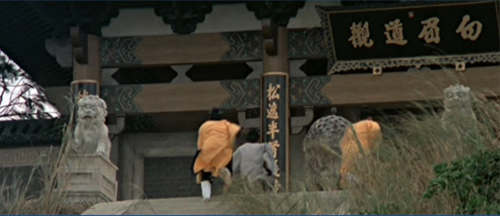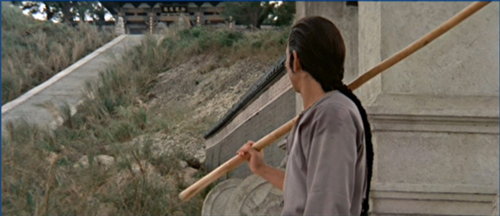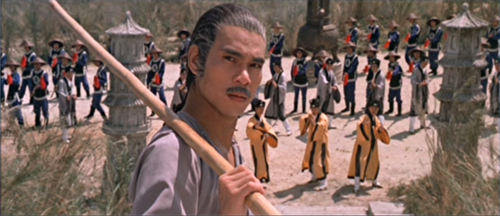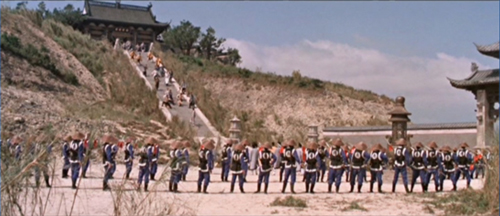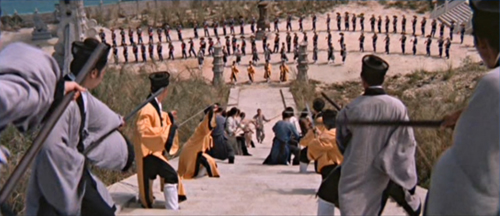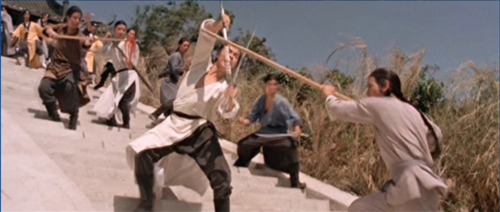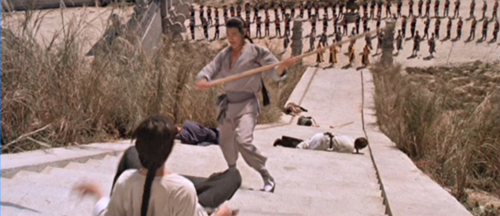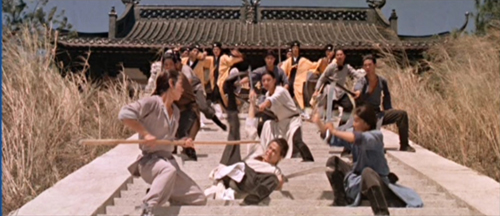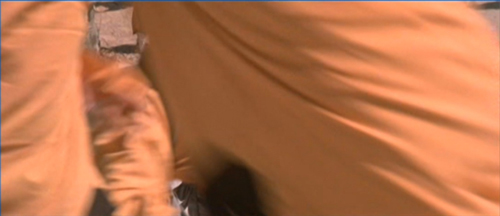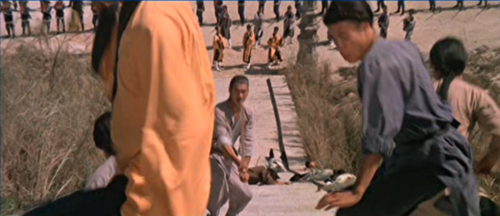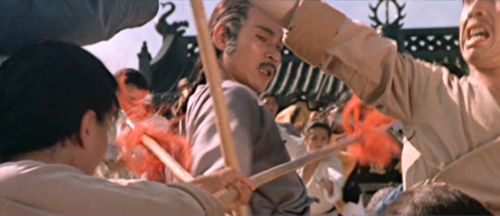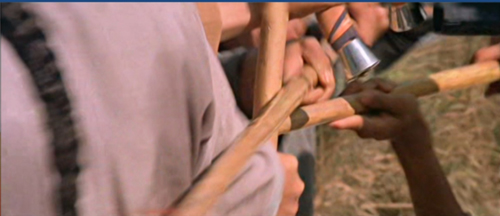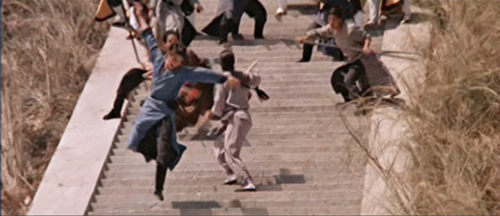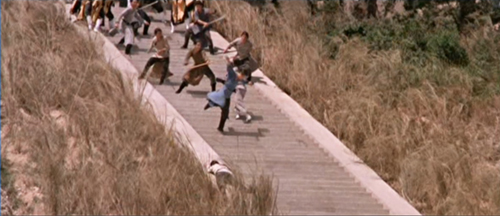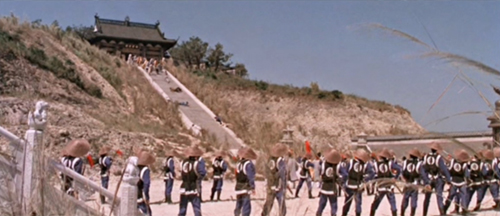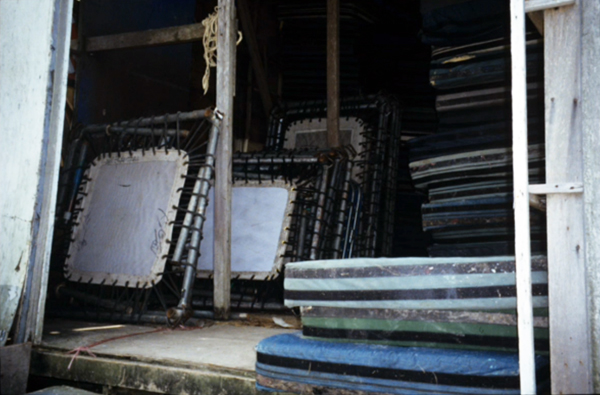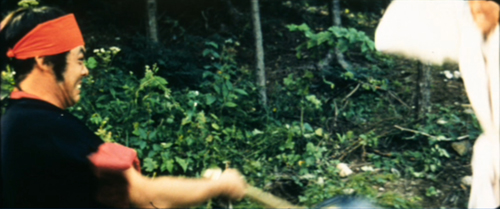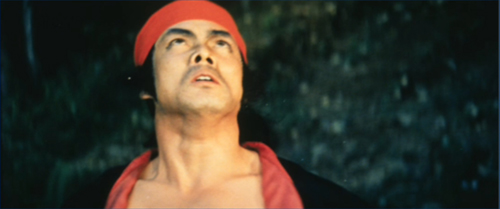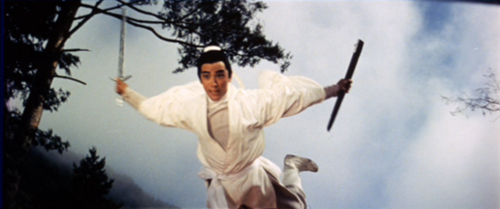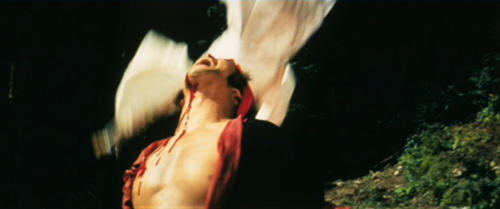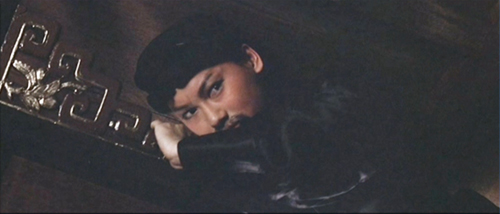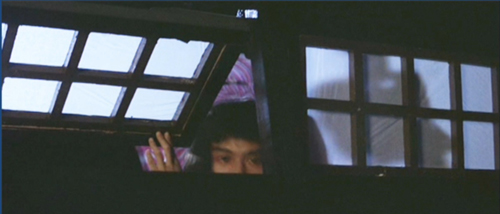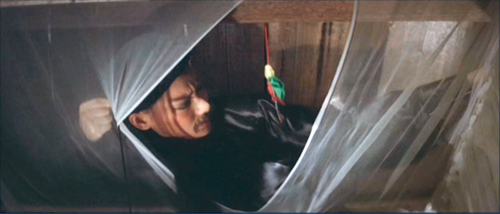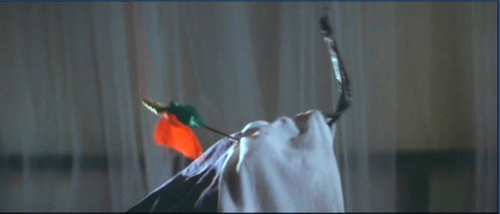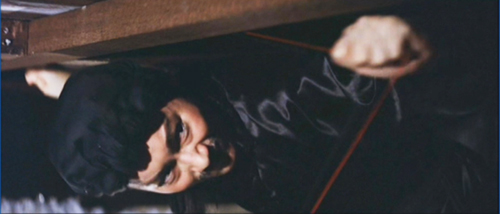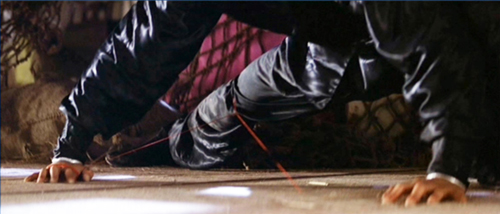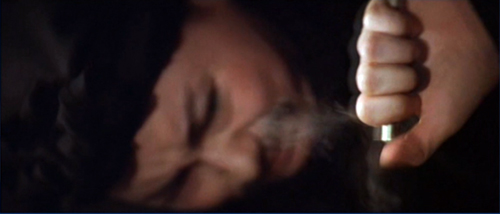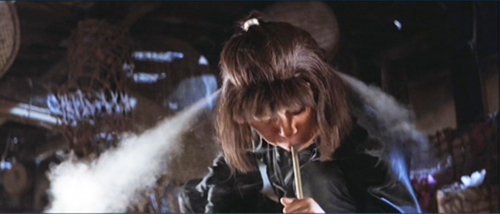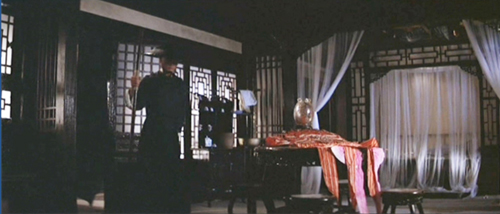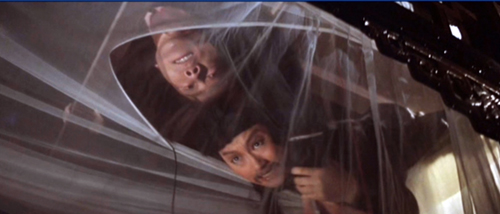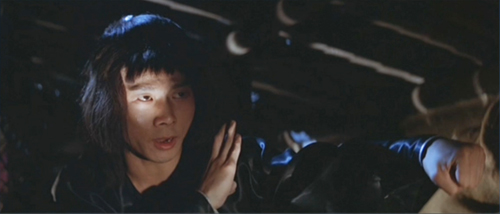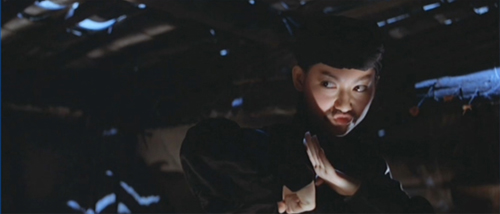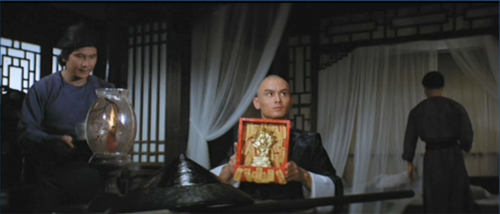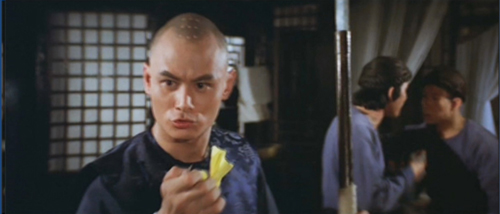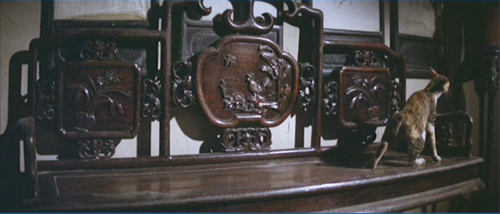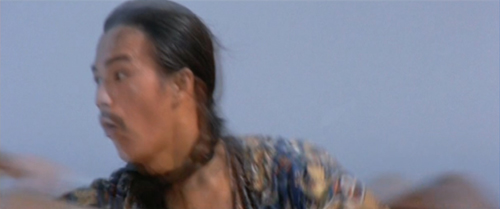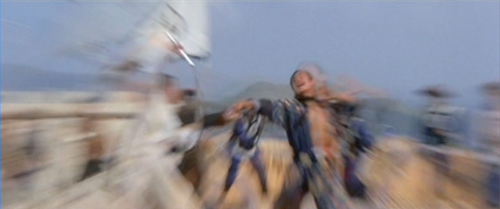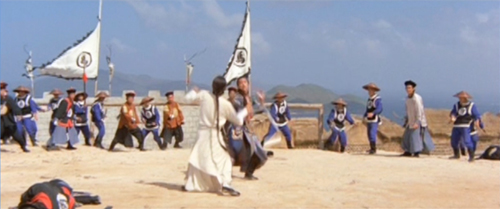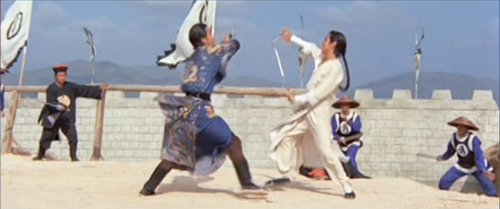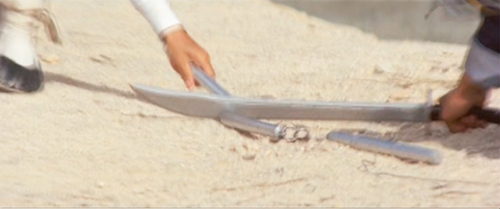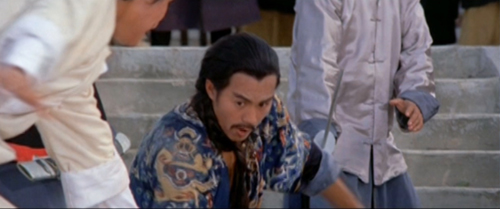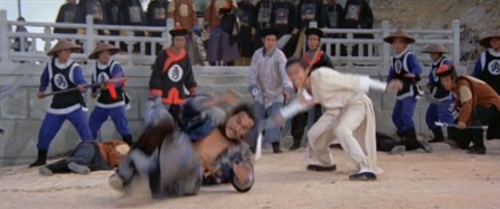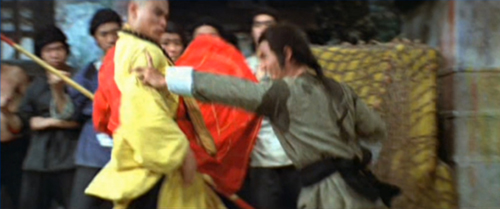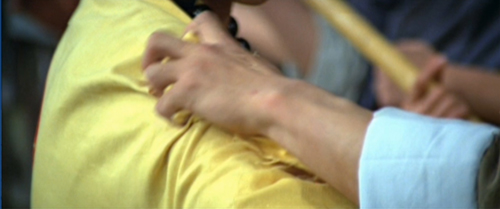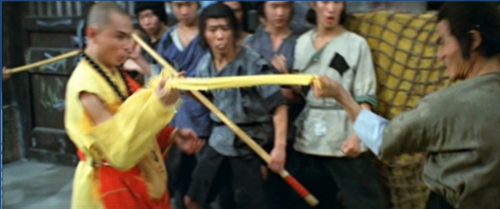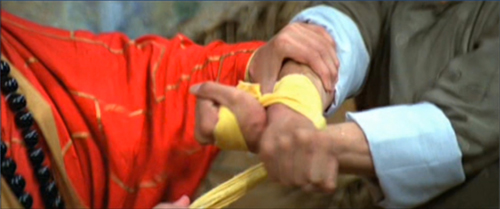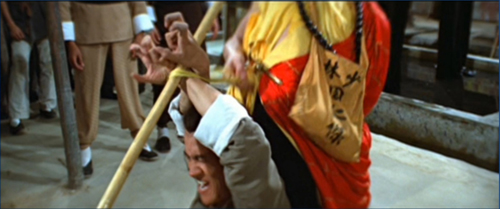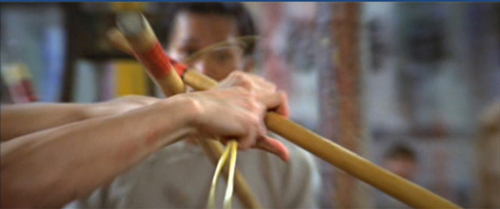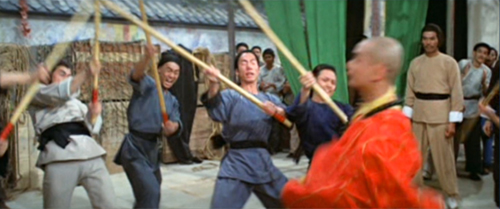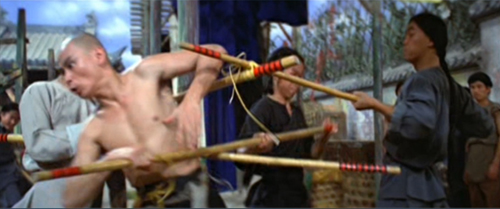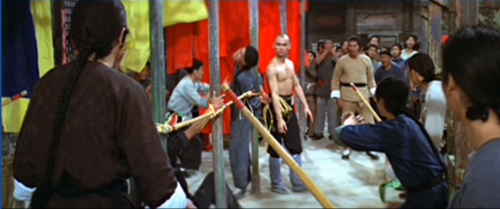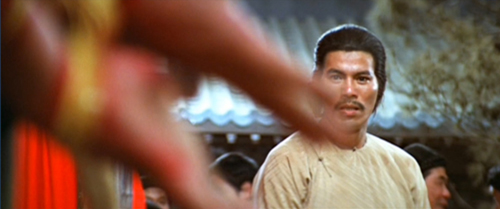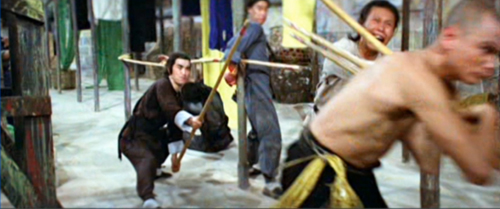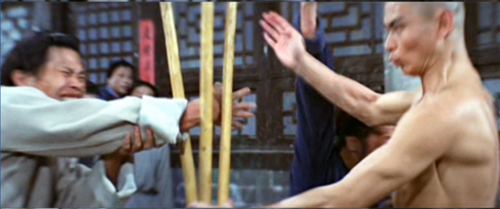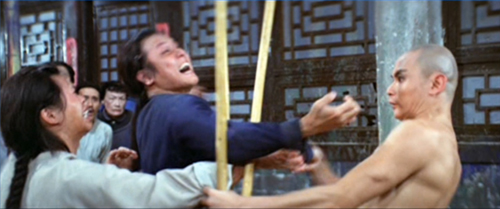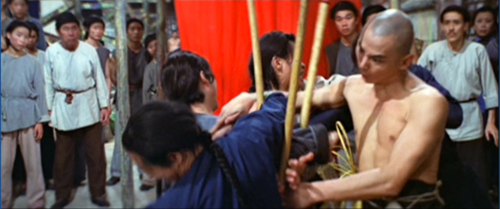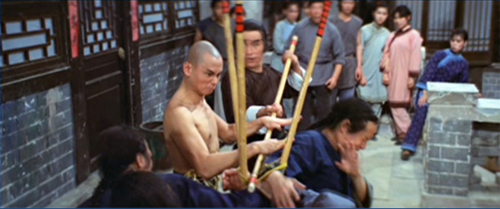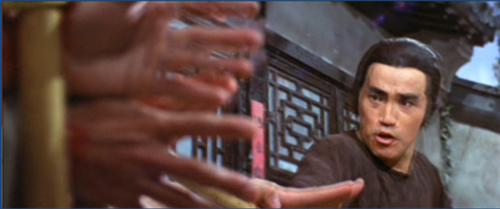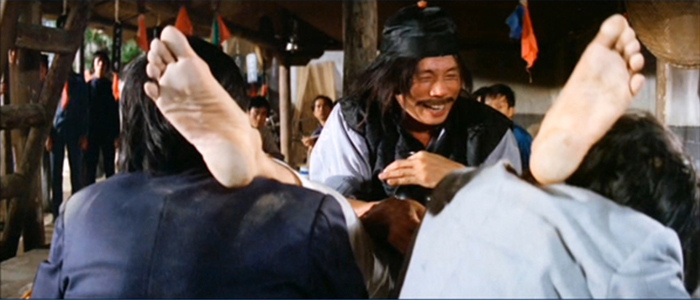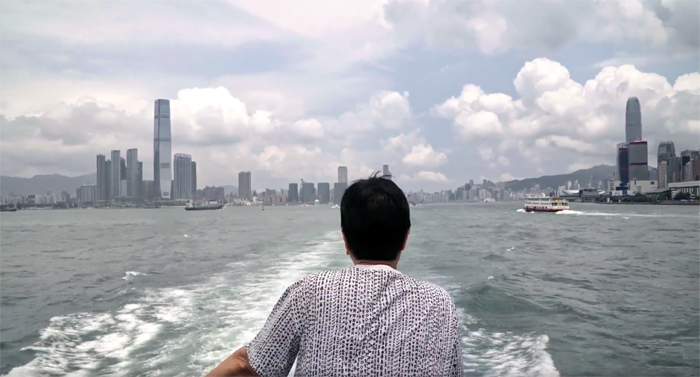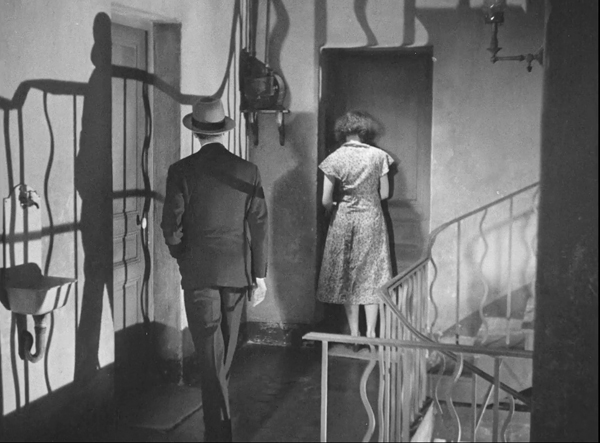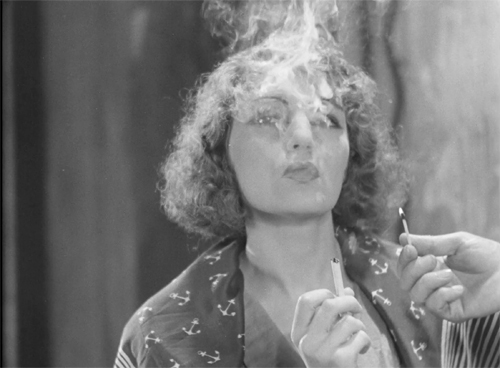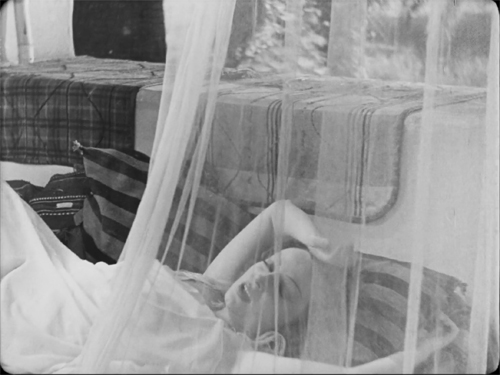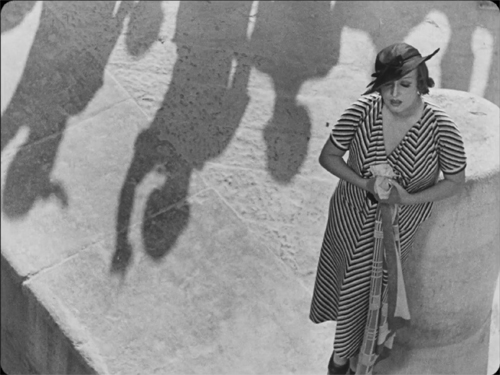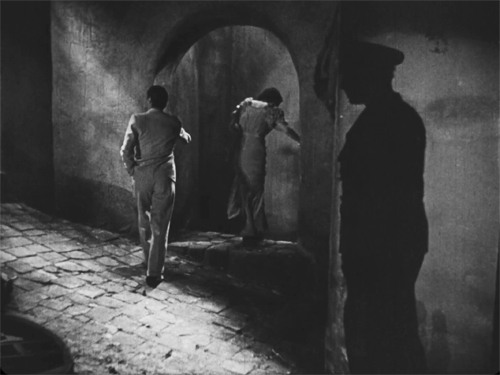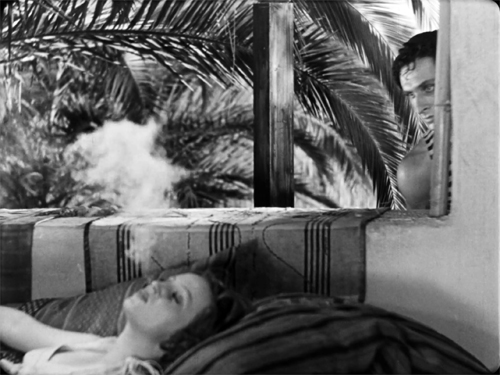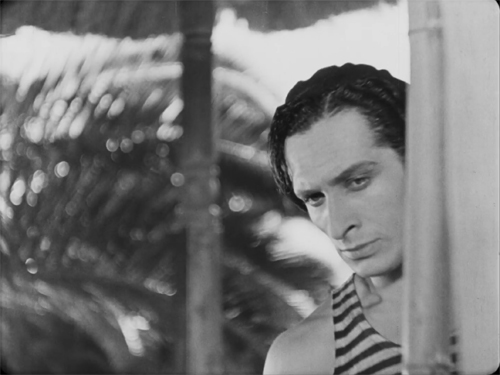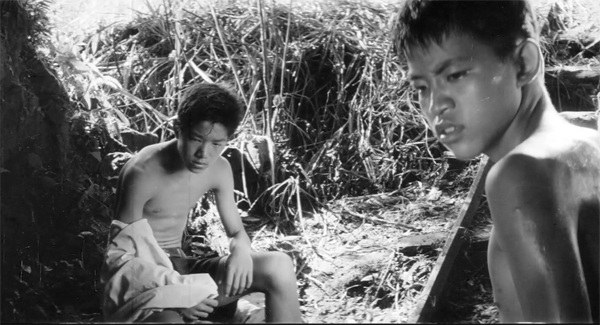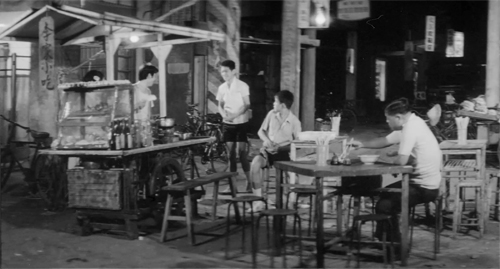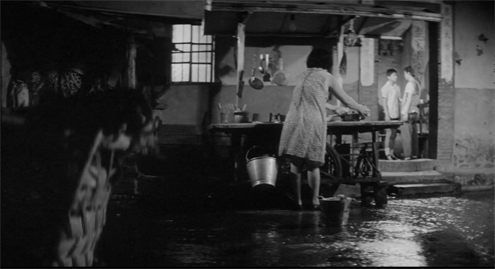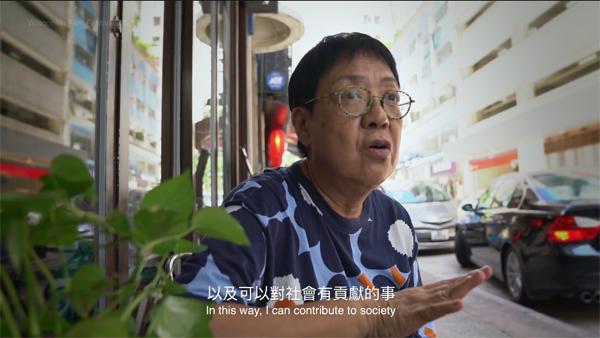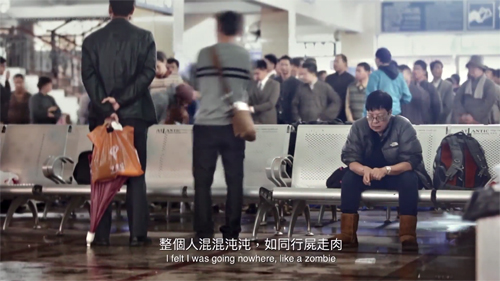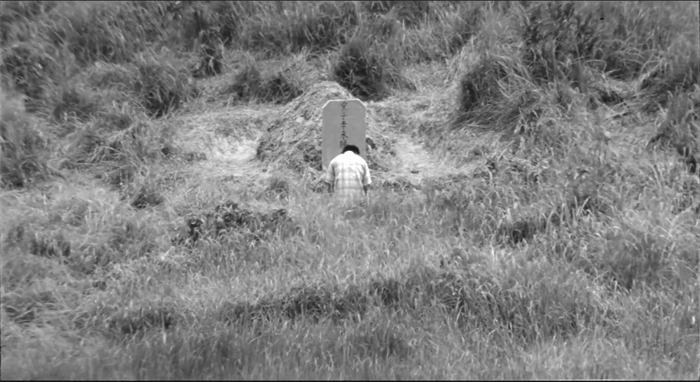Archive for the 'National cinemas: Hong Kong' Category
David Bordwell’s Hong Kong Connection: A Guest Post by Li Cheuk-to
David shopping during his first trip to Hong Kong, 1995
Kristin here:
By now many of you have watched the recording of David’s May 18th memorial service, linked in the previous entry. Some have written to tell me how moving it was and how many aspects of David’s personal life and career the speakers covered. Absent, however, was one of the greatest loves of his professional life: his many visits to Hong Kong and his book on that city’s cinema were represented only by a video recording of his acceptance of an Asian Film Award in 2007. It was a lovely moment, but no one who could present personal recollections of David’s Hong Kong connection was among the speakers.
Now, however, Li Cheuk-to, David’s close friend throughout his days in Hong Kong and our visits to Il Cinema Ritrovato in Bologna, has written a piece that paints a vivid picture of David’s visits to Hong Kong. It conveys his deep enthusiasm for a national cinema that had largely been dismissed by critics and scholars in the West. The piece was posted online in Chinese on March 28, and Ah To, as we knew him, has kindly agreed to having the English version posted here.
Going back through the blog, I have found and linked entries written by David and describing some of the events that Ah To mentions below.
Planet Hong Kong
David in his element, 2000
David Bordwell passed away at the end of February, and the global mourning voices far exceeded the reaction to the death of any other film scholar. This proves that his wide circle of friends and profound influence go beyond the identity of a university professor. Apart from colleagues and students in academia, more responses came from friends he met at film festivals around the world, filmmakers, and fans who interacted with him through the blog “Observations on Film Art.” But what we feel most intimately connected to is his book Planet Hong Kong: Popular Cinema and the Art of Entertainment, in which he celebrated Hong Kong cinema as a self-sufficient industrial system outside Hollywood, possessing its own unique aesthetics. While he also introduced films from many countries around the world in Film History: An Introduction, the only national cinemas he wrote individual books on were American and Hong Kong cinema.
Bordwell’s works are generally more enjoyable than most academic writings. They are remarkably well-written, free of pedantry, and often sprinkled with witty humor. What’s rare is that he isn’t deliberately trying to be accessible; rather, he enthusiastically shares his insights with readers with an open mind, without any hint of the condescending attitude that many scholars inevitably adopt. In this respect, he is as easy-going as his writings; we all enjoy conversing with him because he never makes you feel inferior. He is also a willing listener who is open to different opinions, making it easy to achieve fruitful two-way communication. Expert on Chinese cinema Shelly Kraicer believes that he perfectly embodies the democratic spirit of American scholars and the tradition of trusting students’ intelligence, in contrast to the elitism of the European academia. I can’t agree more.
A fanboy’s first trip to Hong Kong
Planet Hong Kong as one of Bordwell’s most popular works stands out in these aspects, but it is by no means a coincidence. Because he openly admits that he has been an otaku (geek, nerd, or enthusiast) since childhood, discovering Hong Kong cinema through the kung fu films of the 1970s (Five Fingers of Death, Jeong Chang-hwa, 1972, and Fist of Fury, Lo Wei, 1972), just like many Western fans of Hong Kong movies. He even screened some of them in his classes. Unsatisfied with the usual channels like cinemas and film journals, he subscribed to fan magazines and collected videotapes and laserdiscs to update his knowledge of Hong Kong films. Therefore, he embodies a dual identity of a small fan and a distinguished professor, yet he neither falls into the fanaticism of a fanboy nor keeps a distance with the subject of study like most scholars. Instead, he maintains a clear-headed, heartfelt love for these films.
In 1995, his first visit to Hong Kong to attend the Hong Kong International Film Festival became a pivotal turning point. It was not only the centenary of cinema, but more importantly, the festival’s programme that year broadened his horizons. The new friends he made there made him feel at home, and he fell deeply in love with the city of Hong Kong: This will always be the place!
He wrote about the awe he felt sitting in the front row of the Hong Kong Cultural Centre’s Grand Theatre watching Abbas Kiarostami’s Under the Olive Trees. He also had the chance to see the newly unearthed Love and Duty with Ruan Lingyu (Bu Wancang, 1931), as well as new prints of The Orphan, starring the young Bruce Lee (Lee Sun-fung, 1960) and The Eight Hundred Heroes (Ying Yunwei, 1938). The festival that year opened with In the Heat of the Sun (Jiang Wen, 1994) and Summer Snow (Ann Hui, 1995). He could rewatch his beloved Chungking Express (Wong Kar Wai, 1994) and catch up on Hong Kong gems from the same year like He’s a Woman, She’s a Man (Peter Ho-Sun Chan, 1994), The Private Eye Blues (Eddie Fong, 1994), The Final Option (Gordon Chan, 1994), and The New Legend of Shaolin (Wong Jing and Corey Yuen, 1994). (Below, David and Peter Ho-Sun Chan.)
During that year, he also attended the presentation ceremonies of the Hong Kong Film Critics Society Awards and the Hong Kong Film Awards, where he met his admired stars and directors such as Wong Kar Wai, Ann Hui, and Tsui Hark, feeling ecstatic like a fanboy. (Above, David presents the Best Director award from the Hong Kong Film Critics Society for Ashes of Time.) However, more importantly, through the friends he made at the film festival and his experiences walking the streets and marveling at the architecture of Hong Kong, he truly felt the vibrant energy, fast pace, and visual stimulation of Hong Kong cinema, realizing its inseparable connection to the place and its people.
He admitted to becoming addicted to visiting Hong Kong from that point on, continuously attending the film festival in March and April for seventeen years without interruption. In 1997, he wrote an article titled “Aesthetics in Action: Kung Fu, Gunplay, and Cinematic Expressivity” for the Hong Kong cinema retrospective catalogue Fifty Years of Electric Shadows. The following year, he wrote “Richness through Imperfection: King Hu and the Glimpse” for the retrospective catalogue Transcending the Times: King Hu and Eileen Chang. In retrospect, these two articles were early drafts of what would later become Planet Hong Kong. The former used Lethal Weapon and A Hearty Response (Norman Law Man, 1986) as examples to illustrate the stylistic differences in handling action scenes between Hong Kong films and Hollywood, which he also presented during a three-day symposium at the film festival, where the audience erupted into thunderous applause after the screening of the car chase scenes from the two films – what a memorable moment!
In fact, in the two to three years around the time of the handover in 1997, every time he visited Hong Kong, he met with many Hong Kong filmmakers in preparation for his book Planet Hong Kong. One unforgettable memory was a late-night gathering at the end of 1997 with members of the Hong Kong Film Critics Society, where they talked until the early morning and even went karaoke together! Keeto Lam and Bryan Chang still remember that he sang “All Kinds of Everything” and “Losing My Religion.” During that time, we agreed to have the translated version of the book edited by me on behalf of the HK Film Critics Society. After he completed the first draft the following year, he sent me a copy for review. The scene of staying late at the office and discussing the content with him over a two-hour long-distance call is still vivid in my memory today.
A fixture in Hong Kong film culture
Seated, left to right, Shelley Kraicer, Athena Tsui, David, Erika Young, Nat Olson,
and standing, Ann Gavaghan, Tim Youngs, and Li Cheuk-to
Planet Hong Kong was published in 2000 (and in translation by Ho Wai-leng, Hong Kong: Hong Kong Film Critics Society, 2001) , and there was not enough time to write about Johnnie To in his Milkyway Image period in the book. However, when he was invited to be a visiting professor at the Hong Kong Academy for Performing Arts in 2001, he visited the set of Running Out of Time 2 (2001) and the two hit it off immediately. Since then, every time David visited Hong Kong, Director To extended his hospitality, and in the second edition of the book in 2010, David filled this gap and resolved any regrets. (Below, from the left, standing Lau Ching-wan, Shan Ding, and Johnnie To; sitting, Ekin Cheng Yee-kin, David, and Kristin)
During this decade, the most special moment was in 2007 when he was awarded for “Excellence in Scholarship in Asian Cinema” at the inaugural Asian Film Awards, with Johnnie To as the presenter. Just like when he first visited Hong Kong, he took photos of and collected autographs from the surrounding stars and directors. Before the awards ceremony, in addition to discussing the content of the citation with Grady Hendrix, I also had Bryan Chang create a short complementary video featuring a stack of a dozen books that David had given me.
[Note: The online recording of David’s memorial service includes the presentation of the award, including Bryan Chang’s brief film. KT]
Two years later, he was invited to speak at a panel discussion on “The Controversial Centenary of Hong Kong Cinema” at the film festival, along with Law Kar, Frank Bren, and Wong Ain-ling, where they weighed the evidence for and against Stealing the Roast Duck (Leung Siu-po, 1909) and Zhuang Zi Tests His Wife (Lai Park-Hoi and Lai Man-Wai, 1914) as the first film made in Hong Kong.
Law Kar, Wong Ain-ling, Li Cheuk-to, Frank Bren, and David
However, what excited him the most at that edition of the film festival was probably the “A Tribute to Romantic Visions” retrospective celebrating the 25th anniversary of Film Workshop (co-founded by Tsui Hark and Nansun Shi), featuring screenings, exhibition, publication, lectures, and parties, creating a star-studded and bustling atmosphere. Additionally, the successful restoration and resurfacing of Fei Mu’s lost work Confucius (1940) was also a great pleasant surprise for him.
A fanboy’s last trip to Hong Kong
Unfortunately, around the same period, when he came to Hong Kong to attend the film festival, he experienced respiratory issues perhaps due to the air pollution in Hong Kong, often coughing uncontrollably. Athena Tsui remembers accompanying him to a private hospital for a late-night visit (to avoid disrupting the next day’s work), where they even summoned a radiographer in the middle of the night to take X-rays for him, and he quickly received the results, indicating no immediate danger. After returning to his home country, he showed the report to his own doctor, who greatly praised the professionalism, efficiency, and expertise of the Hong Kong medical staff, once again leaving him in awe.
Due to this chronic lung condition, he heeded the doctor’s advice not to come to Hong Kong for two years. In 2014, he accepted an invitation to join the jury for Young Cinema Competition at the film festival (other jury members included Bong Joon-ho, Karena Lam, and Christopher Lambert, above), marking his final visit to Hong Kong. Nevertheless, being able to see the director’s black-and-white version of Mother and engage in deep discussions with Bong Joon-ho could be considered as leaving a good memory, right? In the following years, the only occasion where he would meet with me annually was at the Il Cinema Ritrovato Festival in Bologna, Italy at the end of June, where he always appeared alongside his wife, Kristin Thompson.
Kristin is also a renowned film scholar who co-authored two classic film textbooks with David, and their blog was co-written, as we all know. However, she is also an Egyptologist who conducts research in Egypt once a year, like David’s annual visits to Hong Kong. Over the years, she accompanied her husband to the film festival in Hong Kong once in 2000. Athena Tsui remembers their fondness for desserts from The Sweet Dynasty, such as walnut and almond soup.
David particularly enjoyed mango pudding and was a regular customer at Hui Lau Shan. Before the closure of KPS Video Express, he would always buy many Hong Kong movie laserdiscs whenever he visited Hong Kong.
[Note: Many of these laserdiscs are now in David’s and my collection in the Wisconsin Center for Film and Theater Research. KT]
In recent years, due to the COVID-19 pandemic, we naturally missed the chance to meet again. Last September, I had planned to visit him in Wisconsin, Madison after attending the Toronto International Film Festival. Unfortunately, his health deteriorated, requiring hospitalization, and we missed seeing each other once again. Occasionally, we would receive emails from Kristin updating us on his condition. Eventually, we received the sad news of his passing. It was reassuring to know that in his final days, they would watch a movie together every night, and on the last night, they rewatched two episodes of The West Wing. For those who truly care, this was a comforting end.
Lastly, it must be noted that six years ago when we decided to publish the translated version of the second edition of Planet Hong Kong (with the new material translated by Li Cheuk-to, aided by a few friends), he promptly wrote a new postscript for it without hesitation, for which we are truly grateful. Looking back today, when we sent him the printed translated version four years ago, he was still well amid the pandemic. Undoubtedly he was delighted to see that he finally completed a full circle with his connection to Hong Kong cinema. At the time, this Chinese version was meant to commemorate Wai-leng. Today, as David has passed away, I realize that this can also be seen as showing our utmost gratitude and respect to him.
The second edition of Planet Hong Kong is available for free here. There is still a notice about not copying the book for others, but that is left over from the days when David was selling his digital books online. The page where the book is available also has David’s description of how he came to love Hong Kong cinema, visited Hong Kong for the festival, and wrote the book.
The blog entries on Hong Kong that I have linked here are only a few of the many he posted. The rest can be found by clicking on the “National Cinemas: Hong Kong” link in the menu at the right.
Li Cheuk-to, photographed by David in 2000
Thank you, Lignan
DB here:
On 2 November, Lignan University of Hong Kong conferred upon me an honorary doctorate. My health situation kept me from attending, but I sent a statement of thanks. I’m grateful for the honor, and for Professor Darrell Davis for reading it at the ceremony (pictured above). Here it is.
I am deeply proud to receive an honorary doctorate from Lingnan University. It is one of the jewels in the crown of Hong Kong higher education. I have enjoyed my many visits to the campus and have made many friends during that time. Conversations with them have inspired me to improve my work.
I fell in love with Hong Kong film before I came to love Hong Kong. In the 1970s I was deeply moved by Bruce Lee’s films beyond their obvious visceral appeal, they showed a young Chinese man standing up for justice and righteousness. I now realize that Bruce Lee embodied the dignity and compassion for others that remain central to the spirit of Hong Kong itself. In the years that followed, my appreciation of Hong Kong cinema grew, and I was inspired to express my ideas in a book on it. As I became more acquainted with its many fine filmmakers and the craftspeople who supported them, I came to realize that the same spirit has continued in this film culture.
My admiration for Lingnan, therefore, is part of my overall respect for the excellence of Hong Kong cinema and of the community it represents.
I regret that my health situation does not allow me to participate more fully on today’s occasion, but remain assured that my heart is with Lingnan University, its students and faculty, as well as the people of Hong Kong.
My thanks to the University, to Professor Davis and Profesor Emilie Yeh Yueh-yu (below), and to Ginn Fung Kai Chun and Amy Pang Wing Si for their kind assistance.
Lau Kar-leung: The dragon still dances
Lau Kar Leung (aka Liu Chia-liang, 1936-2013); Gordon Liu Chia-hui (aka Lau Kar-fei, 1955-).
DB here:
Back in 2020, I was asked to prepare a video lecture on the Hong Kong filmmaker Lau Kar-leung. Under the auspices of the Fresh Wave festival of young Hong Kong cinema, a retrospective and panel discussions were sponsored by Johnnie To Kei-fung and Shu Kei. The event took place in summer 2021. Tony Rayns also participated, offering a deeply informative talk that’s available here, but mine was not included. At a time when I hope people will continue to remember all that Hong Kong popular culture has given us, I’ve recast it as a blog entry.
For some years I’ve been arguing that the martial arts cinema of East Asia constitutes as distinctive a contribution to film artistry as did more widely recognized “schools and movements” of European cinema like Soviet Montage and Italian Neorealism. The action films from Japan, Hong Kong, and Taiwan have revealed new resources of cinematic technique, and the filmmakers have influenced other national cinemas. The power of this tradition is particularly evident in Hong Kong cinema’s wuxia pian (films of martial chivalry), kung-fu films, and urban action thrillers from the 1960s into the 2000s.
Chinese martial arts are well-suited to the movie screen. The performance discipline, seen both in the martial arts and in theatrical traditions borrowing from them, yields a patterned movement that lends itself to choreography. The staccato quality of motion yields a pronounced pause/burst/pause rhythm that can be displayed and enhanced by film technique, as we’ll see.
These aspects of martial arts were captured by filmmakers working for the Shaw Brothers studios between 1965 and 1986. They cultivated a local style that yielded films that looked unlike any others. Thanks to the immense resources of the Shaw Movietown studio, complete with big sets and collections of costumes, the new filmmaking style was given a unique force. With The Temple of the Red Lotus (1965) and Come Drink with Me (1966), what Shaws called its “action era” began, and thanks to international distribution Shaws’ swordplay films gained audiences around the world.
Shaws’ Big 3
Shaw Movietown main office, 1997. Photo by DB.
The new trend benefited from Chinese opera traditions and the martial arts novels of Jin Yong, pen name of Louis Cha Leung-yung. They also owed a debt to Japanese swordplay films, many of which Shaws distributed and urged their directors to study. There was as well the influence of Italian Westerns. Just as important was Shaws’ investment in color and widescreen processes. Updating technology not only allowed the films to compete on the world market; it offered rich opportunities for artistic expression. (See the essay “Another Shaw Production: Anamorphic adventures in Hong Kong.”)
Shaws directors quickly established conventions of the new swordplay film. Conflicts, of course, were expressed through combat, at least three major ones per film. One source of friction was the rivalry between martial arts schools run by masters; there might also be competition among traditions, regions (northern/southern), or nations (China vs. Japan). Typically there would be a hierarchy of villains, with our protagonists fighting them in turn. Plots would be more episodic than is typical in Western films. A looser structure favored including extensive set pieces of training or combat that were the appeal of the genre. And the plot would culminate in a long climactic fight, often to the death. These conventions, consolidated in the wuxia pian, carried over into the kung-fu films of the 1970s.
Two directors played central roles in shaping these conventions, and each had a distinctive approach to them. The vastly prolific Chang Cheh (Zhang Che) dominated the Shaws lot. He favored violent plots turning on revenge and intense male camaraderie, in which the martial arts served as a drama of loyalty or betrayal, friendship or deadly enmity. At the same period King Hu Chin-Chuan created one of the breakthrough “action era” works, Come Drink with Me, which immediately established a very different authorial vision. Hu was interested in historical and political intrigue, women warriors no less than male ones, and the martial arts as a spectacle of cinematic grace. Most of his major works, including A Touch of Zen (1971) were produced after he emigrated to Taiwan, although some were distributed by Shaw Brothers.
Neither Chang Cheh nor King Hu was trained in the martial arts, so they relied on choreographers to supply their action scenes. By contrast, Lau Kar-leung was a martial arts director who came to Shaws in the 1960s and choreographed many films for Chang and others. He took over directing duties in 1976 with The Spiritual Boxer and directed over twenty-five films for Shaws until 1985, when the company ceased producing theatrical features. He went on to direct several one-off projects until 2002.
Lau took the uniqueness of martial arts traditions more seriously than other directors, building entire films around one school or another, or among the contrast of rival traditions. He often opens the film with an abstract prologue showing off characteristic moves and tactics of the style that the film will treat. Unlike Chang, he is less concerned with male loyalty and violent revenge and is more inclined toward redemption and forgiveness. He shares Hu’s refined conception of film technique, but he is less overtly innovative. He refined stylistic conventions that were already in place at Shaws and many of which were basic to world cinema storytelling.
For example, Lau accepted the elevated production values demanded by the Shaw product. His films are filled with elaborate sets, both interiors and exteriors, and rich color values. He also recognized the power of editing, something that King Hu had brought to the fore. In the rest of this entry, I’ll concentrate on four of Lau’s distinctive innovations in the Shaws style.
Filling the wide frame
All widescreen filmmakers faced the problem of filling the spacious frame. (See CinemaScope: The Modern Miracle You See without Glasses” for discussion of American solutions.) The big Shaws sets enabled filmmakers to pack the frame with figures and settings. We therefore find plenty of dense long-shot compositions.
We also find flashy closer views. Chang Cheh was particularly fond of low-angle medium shots, which he considered “warmer” than straight-on or high angles (The Assassin, 1967; choreographed by Lau).
Hong Kong directors relied on “segment shooting” for action scenes. Instead of overall coverage, with repetitions for different camera angles (the US norm), they plotted the fighting moves for specific camera angles and shot them separately. By calibrating the performers’ actions to the camera setup, they created a unique blend of martial arts techniques with film techniques. Rather than simply record martial-arts movements, filmmakers “cinematized” them.
Lau seems to have taken particular pleasure in filling his frames in ingenious, fluid ways. He enjoyed the challenge of staging combat scenes in confined spaces, so that he couldn’t rely on expansive vistas. Partly, this tactic enabled him to show how different moves were required in close quarters. One of his favorite sequences was in Martial Club (1981). He explained:
Gordon Liu is fighting Johnny Wong in an alley that narrows from 7-foot to 2-foot wide. The physical limits of the alley actually make the best showcase for the different boxing schools. How do you fight in a seven-foot-wide alley? You use big arm and leg movements. Going down to five-foot wide, you keep your elbows close to your body because you don’t want to expose yourself. Further down to three-or-four foot wide, you use Iron String Fist. Finally when you get down to two-foot wide, you engage the “sheep trapping pose.” The results were sensational.
At the same time, the narrowing alley offered rich opportunities to fill the frame with body parts and abstract slices of walls.
Something similar occurs in Legendary Weapons of China (1982), where two assassins must hide in an alley above a third. This time Lau uses some props to fill out the wall areas.
Lau delights in the possibilities of close fighting in any space. Sometimes the confinement isn’t a matter of setting; it’s dependent on letting the film frame itself constrain the action. Take a portion of a sequence from Dirty Ho (1979). The Prince (in disguise) calls on Mr. Fan, who tries to attack him, all the while pretending to play the host by offering wine.
Establishing shots lay out the zones of action to come, the chairs the men will occupy. Even a momentarily unbalanced framing is compensated for by movement in the empty area.
The first phase of the scene takes place in much closer framings, often tight two-shots. It’s here we see Lau’s virtuosity in finding constantly fresh ways to fill the frame, with compositions always picked for maximum clarity: that is, in showing Fan’s aggression and the Prince’s resourceful blocking, sometimes with comic symmetry.
The pause/burst/pause rhythm gets played out in low angles, with slight camera movements to adjust to the gestures.
The two major props, the fan and cups, get a real workout as they participate in the constant ballet of arms, faces, and fingers. All areas of the screen get activated: top, bottom, corners and sides.
Later in the scene, in a passage I haven’t included in the clip, the servant gets to take part, so now even more body parts are spread across the frame–and a cup even comes out at the viewer.
The scene ends with a comic commentary on the props: master and servant collapse at the table as a cup overturns.
This “close-up action scene” is as fully designed for the widescreen as any expansive long-shot sequence might be, but there’s a particular enjoyment to be had in seeing how a director can do so much with simple components.
Editing: Analytical cutting
Contrary to what many think, Chinese action pictures rely heavily on editing. At Shaws, King Hu pioneered extremely rapid cutting, reducing shots to half a second or less. Lau became a rapid cutter as well; his films from the 1970s and 1980s typically average three to five seconds per shot, with some films containing over 1000 shots.
It’s commonly said that Hong Kong martial arts films favored full shots and long takes, the better to respect the overall dynamic of the combat. Full shots, yes; but not necessarily long takes. While Western directors tended to believe that long shots had to be held quite a bit longer than closer ones, Hong Kong directors realized that long shots could be cut fast if they were carefully composed for quick uptake. Lau’s mastery of composition stands him in good stead when he starts putting shots together: every combat, even the fast-cut ones, are crystal-clear in their execution.
Directors across the world had settled on two major editing resources: analytical cutting and constructive cutting. The first type shows the overall spatial layout of a scene and then analyzes it into partial views. Our Dirty Ho sequence is an example. Constructive cutting deletes the establishing shot and relies on other cues to help the viewer build up the scene mentally. Hong Kong filmmakers made extensive use of both types, and as you’d expect Lau is a master of each.
Most Hong Kong directors used analytical editing to favor the actors, to pick out their reactions to the ongoing action. Lau does this as well, as is seen in Dirty Ho. As you’d expect, Lau also uses cuts-in close views to emphasize combat tactics. In Challenge of the Masters (1976), after a villain (played by Lau) has felled his opponent, analytical cuts build to a revelation of a metal attachment to his shoe.
Executioners from Shaolin (1977) illustrates how Lau uses analytical editing during a large-scale fight scene. It’s far less constrained than the tabletop action of Dirty Ho, but he does find ways to narrow the action to particular zones. This is done through cuts to closer views–sometimes very close ones. And the editing is swift, with the average shot lasting only four seconds.
The scene’s opening establishes the hero Hung Hsi-kuan arriving at Pai Mei’s temple. There are two establishing shots, one a pan-and-zoom that presents the temple as Hung arrives, while the other (below) is a zoom back keeping the temple and Hung in the same frame. Both compositions stress the steep stairs leading up the hillside.
Once Hung starts up the stairs, more establishing shots reveal him surrounded. Lau indulges in a feast of different angles, stressing Hung’s vulnerability.
The scene’s second phase follows Hung’s progress up the steps. His encounters with many defenders are captured in a variety of angles, all of them orienting us to the changing situation. (At the top, he’ll encounter Lau himself, wielding a jointed staff.)
Camera setups on the steps themselves keep us aware of the forces arrayed around him. And the steps function a bit like the alleys in other films to limit the range of action.
The camera really penetrates the action, picking out details in the sort of tightly packed framings we saw in Dirty Ho.
Lau remarks: “You can get wonderful scenes of two pairs of hands folding and sliding in and out of each other’s grip.” This sort of tangible physical action is central to Lau’s scene analysis.
Analytical editing can include matches on action, cuts that let movement carry over across shots. Lau gives a virtuoso example in a match-on-action between extreme long-shots of a man in blue sent sprawling. The second shot ends with a zoom back.
It’s possible that Lau used two cameras for coverage of this, but that was a rare option in Hong Kong. It’s just as likely he managed the cut by repeating the fall, a movement stressed by a zoom back.
Again, you get a sense of a filmmaker challenging himself by setting up problems he will need to solve through mastery of his craft.
Editing: Constructive cutting
Trampolines and mattresses in shed on Shaw Movietown lot. Photo by DB.
The wuxia tradition features exponents of the “weightless leap,” the ability to spring very high into space. Before the advent of wirework and CGI, these soaring warriors were treated through editing that shows the leap in a series of shots. For instance, constructive cutting in Chang Cheh’s Golden Swallow (1968, choreographed by Lau) shows Silver Roc launching himself, soaring, and descending on his victim.
The jump was probably facilitated by a trampoline. On the screen, though, we see portions of the action that we assemble in our heads.
With his usual ingenuity, Lau sought out situations where he could test his skill with constructive editing–not just weightless leaps but combats among fighters at some distance from each other. My example is a brilliant sequence from Legendary Weapons of China (1982). (It takes place in semidarkness, so you may wish to adjust the brightness of your monitor.) Two rival assassins clash in a loft as they try to kill a third in the bedroom below. There ensues a three-way fight, pursued mostly through careful constructive editing.
There are a few establishing shots situating Ti Hau and Fan Shao Ching (disguised as a man) in the loft, but once they change their locations, most of the combat is given through constructive editing. That technique relies on cues of setting and character behavior (body position, facial expression, eyelines), and these are all mobilized early in the scene.
Details of props help us understand the action as well: the two threads bearing hooks and especially the gag with gas.
Once the assassin Ti Tan arrives on the floor below, pure constructive editing takes over. There’s no framing that includes him and his two attackers.
So Lau proceeds to cut together an ongoing fight upstairs (complete with fake meows) with Ti Tan’s suspicions downstairs.
The scene culminates in Fan and Ti Hau fleeing as Ti Tan, still suspicious, doubts that all the noise above him was created by a cat–and even the cat is presented through constructive editing.
In a sequence of 126 shots, the average is about two seconds, but each one is legible at a glance and carries the scene forward with utter smoothness. Lau’s precision in shot design serves him well when we have to assemble the action in our minds.
The smash zoom
Hong Kong action films of the 1960s are notorious for their use–some would say, over-use–of zoom shots. Yet at the time directors throughout the world were exploring the artistic possibilities of zooms. Most notable was the Hungarian Miklós Jancsó, who coordinated the zoom with complex movements of actors and the camera. So we ought to consider the possibility that the zoom in Hong Kong was more than a technical gimmick to spice up action scenes.
For example, a smash zoom can accentuates the pause/burst/pause pattern of the fight. During one combat in Chang Cheh’s The Blood Brothers (choreographed by Lau), the zoom emphasizes sudden bursts of action by whipping back from a fighter.
Alternatively, the zoom can play up the pause by calling attention to moments of stasis. Here a cut emphasizes the pause as the fighters’s weapons are locked before the fight resumes with a zoom back.
In such ways the zoom can break the fight into discrete stages. A far more elaborate instance takes place in Lau’s Return to the 36th Chamber (1980). Chu Jen-chi has painstakingly learned kung-fu at the temple through an apprenticeship of lashing bamboo poles together to make scaffolding. Accordingly, his technique is based on this very particular set of skills. I concentrate on the early stretches and the clip gives you some extra niceties. The whole thing is exhilarating to behold, thanks partly to energetic zooms.
Early on, the zoom introduces us to the lashing technique by showing the robe’s ripped fabric as a kind of handcuff.
Again we see Lau’s interest in watching how hands work, but here it becomes a specific combat tactic. The ensuing action will revolve around hands and wrists, and Lau’s zooms set up a question: What is Chu’s overall strategy?
The answer comes in a series of variations. First, Chu lashes his adversary to a bamboo pole like captured wild game.
Variation 2: Ensemble work. Chu takes on a batch of men, trussing them up horizontally.
He turns out to have in mind an engineering project, a sort of hitching post of miscreants. It’s capped by a shot of one of the Manchu bullies seeing his disciples’ wiggling fingers.
Variation 3: More ensemble work, now vertical, with the men’s wrists stacked like a bouquet.
Again, a master shot reveals the result and another close-up shows their wiggling fingers.
The kung-fu is of course extraordinary, but it takes an unusual cinematic imagination to heighten such elaborate patterns of movement in ways that are perfectly clear. Chu’s display of serious efficiency has a humorous side, capped by the gags that show the villains utterly flummoxed. We should ask if today’s action sequences in American films have this sort of unforced rigor and exuberance.
In the mid-1980s Shaw Brothers eased out of theatrical filmmaking, devoting Movietown to television production. Lau went on to one-off projects, some of which (e.g., Tiger on Beat, 1988) are well worth your attention. (Go here for the astonishing climax.) He had a late-career resurgence as choreographer for Tsui Hark’s Seven Swords (2005). But his prime achievements, I think, will remain his vastly entertaining and filmically rich Shaws classics. His dedication to the specifics of martial arts lore, his unique sense of comedy, and not least his precise direction brought unique qualities to the remarkable tradition of Asian action cinema.
Chang’s remark about “warm” low angles is in Chang Cheh, A Memoir (Hong Kong Film Archive, 2004), 82; he discusses shooting The Assassin on p. 86. Lau’s comments on Martial Club come from “We Always Had Kung-Fu: Interview with Lau Kar-leung,” in Li Cheuk-to, A Tribute to Action Choreographers (Hong Kong International Film Festival, 2006), 62; the remarks on hands are on p. 59.
I discuss Lau further in both Planet Hong Kong 2.0 and in this blog entry.
Lau as the drunken master in Heroes of the East (1978).
Wisconsin Film Festival 2021: Retrospectating
Keep Rolling (2020).
DB here:
Several of the films I’ve seen this go-round are either revived versions of older films, or recent films indebted to older traditions. Herewith, some thoughts on them.
Tender and tawdry
La Belle de nuit (1934).
I felt less dopey about not knowing about Louis Valray when Serge Bromberg, in an interview on the WFF site with Kelley Conway, confessed he’d not heard of him until he found an incomplete print of Escale (1935) by accident. Bromberg went on to find more footage, discover Valray’s first film, and secure the rights to restore and distribute them. Splendid in their restored versions (with curved corners on the frame), the films are at once generic and pleasingly perverse.
La Belle de nuit (1934) is a boulevard melodrama with hints of Vertigo and Les Dames du Bois de Boulogne. When a playwright discovers his wife has cheated on him with his best friend, he plots vengeance. By chance (i.e., dramaturgy) he finds a prostitute who is almost a dead ringer for the wife. He dresses her up, installs her in an apartment, and coaxes her to adopt a remote, mildly mocking manner. Of course, the treacherous best friend is in a frenzy to possess her. Wait till he learns about the past of his new passion.
La Belle de nuit alternates rather flat scenes of bourgeois flirtation with bursts of cinematic energy. Like other early sound films, there are some sharp auditory transitions. Dynamic hooks link scenes with sounds, images, or both: automobile wheels, locomotives, phonograph records.. There are peculiar angles and, most noticeably, a fascination with the unattainable woman. As ever, cigarette smoke helps the mystique.
I suspect that Valray learned a lot from making this first film because I found Escale a more polished production. Like his debut, it centers on a fallen woman who hangs around hazy cafes where hard-used women stroll among tables and sing about the troubles of life. Jean, an uptight lieutenant on passenger ships, falls in love with Eva, who hangs around smugglers in her seaport town. Jean and Eva share an idyll, and she seems redeemed. But when Jean leaves on a voyage, Eva’s loyal manservant Zama can’t keep her from succumbing to the mesmeric bootlegger Dario.
Escale has more exquisite visuals than La Belle de nuit. Filmed on a lush Mediterranean island, it bathes its landscapes and sea vistas and seedy port with a languid melancholy akin to that of Pépé le Moko (1937). Practically every shot, on land or sea or in the alleys or the boudoir, yields brooding, hypnotic imagery.
I find Escale‘s villain far scarier than the fussbudget playwright of La Belle de nuit. Dario wears more mascara than Eva, but the effect is to give him the burning glance of the true monster.
Both films, available on French DVD, would be a fine double feature for an enterprising US disc publisher or streaming service. Thanks to Bromberg and Lobster Films, they can be seen in their full glory.
A Taiwanese revelation
Just as the Valray films cast a new light on 1930s French cinema, so The End of the Track (1970) puts the standard history of Taiwanese cinema into a fresh perspective. The story is that the New Taiwanese Cinema of the 1980s, developed by Hou Hsiao-hsien, Edward Yang, and others, created a fresh turn toward social realism and more adventurous storytelling. Their tales of rural life and urban anomie clashed with the entertainment genres of commercial cinema and the government-sponsored films asserting that under Chiang Kai-shek’s Kuomintang regime life was buoyant and carefree. With The End of the Track we have a fine predecessor, a “parallel” film that dared formal and thematic opposition to the mainstream, and did so well before the New Wave directors.
Yung-shen’s father and mother run a noodle cart; Hsiao-tung’s family is well-off. But the boys are fast friends. They enjoy long days in their rural paradise–swimming naked, play-fighting, and exploring caves. The film’s first twenty-five minutes are almost plotless, built out of routines of school, play, and homework. But then a crisis strikes, and the film turns achingly sad in a quiet, unmelodramatic way. The plot shifts slowly to a study of how one boy becomes a surrogate son for a grieving family, while his own parents respond uncomprehendingly.
The boys’ skinny-dipping and mud wrestling earned the film a ban for “homosexual undertones and ideology.” There’s surely a homosocial, and maybe homoerotic undercurrent, but the main impression is that of devoted friendship and the heavy weight of obligation. One boy must leave childhood behind, too soon, and start a new life. Just as powerful is the class component. In one grueling sequence, Yung-shen’s parents try to push their cart through typhoon-swept streets as Hsiao-tung’s parents look on from their car.
Pictorially, director Mou Tun-fei makes full use of the glorious scenery that rural Taiwan can yield. He uses fast cutting, handheld shots, abrupt flashbacks, and other “modern cinema” techniques. These techniques can be seen in many commercial Taiwanese films of the period, but most directors used them to jazz up generic plots. Here, the fastidious black-and-white palette gives them a certain sobriety. The gravity is enhanced by severe but lyrical compositions, like this planimetric shot of the boys laying out a running track.
Above all, the slow pace of the film–the basic story is almost an anecdote–allows Mou to soak us in the characters’ milieu. There are even some prolonged, static long shots that look ahead to the precisely unfolding scenes we get in Hou’s films and in Yang’s A Brighter Summer Day (1991).
Mou is now, like Valray, a rediscovered director enjoying belated fame in his national cinema. In a very helpful discussion of his career, Wafa Ghermani and Victor Fan point out that there was at the period an important trend toward independent, low-budget films in Taiwanese (rather than the official language of Mandarin), and Mou’s work is just one example. As usual, a festival screening can remind us that there’s a lot more powerful cinema out there than we’ve realized.
Her time has come
Keep Rolling (2020) isn’t an old film, but it’s about a director who has over forty years quietly carved her own niche in world cinema.
In the 1980s, a new generation of filmmakers overturned Hong Kong cinema. Some, like Tsui Hark, Jackie Chan, and John Woo, brought a turbocharged version of the New Hollywood to a film culture already energized by a tradition of martial-arts action. Other young talents formed what came to be called the Hong Kong New Wave. Although Tsui was sometimes identified with this, this trend was not so brash. It moved toward social realism, with directors like Allen Fong and Stanley Kwan exploring a modernizing Chinese culture living under colonial rule but forging its own identity.
Of all the New Wave directors, Ann Hui distinguished herself by her sincere and dogged attention to Hong Kong life as it is lived. After making some docudramas for television, she directed her first feature, The Secret (1979) and won festival attention with Boat People (1982) and Song of the Exile (1990). Although she has happily embraced genre films–she has made ghost stories and thrillers–she always treats sensational material with a calm, unspectacular attention to characterization and mood. Her swordplay film, the two part Romance of Book and Sword (1987), emphasizes landscape and interpersonal drama over action set-pieces. Who else would make Ah Kam (1996), a martial-arts movie centering on a stuntwoman?? She brought attention to social problems, sometimes in advance of social policies: caring for a parent suffering from dementia (Summer Snow, 1995), the need to shelter victims of marital abuse (Night and Fog, 2009), and lesbian rights in Hong Kong (All About Love, 2010).
In all, she has directed twenty-eight features. Every one has been a struggle.
Because the local market has been small, Hong Kong filmmakers have had to look abroad. For directors like Tsui and Woo, that meant making flamboyant action vehicles for audiences across East Asia, as well as for the Chinese diaspora and fans in other territories. But Ann Hui’s commitment to local life meant that her films had to gain wider attention on the red-carpet circuit. They did. Over the decades, they routinely played the major festivals. Her A Simple Life (2011) got a standing ovation when it played Ebertfest in 2014; Roger called it one of the year’s best films.
Last year Kristin and I were sorry we couldn’t be in Venice to watch her accept a Golden Lion for Lifetime Achievement. In response to my email of congratulation, she was characteristically modest in facing a 14-day quarantine when she returned home. As ever, she makes personal contact:
Tonight I am dead beat n have a whole day of press tomorrow before I leave on the day after. I promise myself I’ll only stick to filmmaking from now onwards. How r u and is the pandemic bad in your area? HK is bad all the way you must know. Will u still come n visit us? Take care n keep well! Ann
Ann’s career receives a fitting tribute in Man Lim-chung’s Keep Rolling. It surveys her life, with fine interviews with her sister and brother, along with comments from friends and critics. There’s a lot of behind-the-scenes production footage. Above all, Man offers a personal portrait of her persistence and dedication. Virtually the only female director to make a career in Hong Kong, she has contributed to the world’s humanist cinema shaped by directors like Kurosawa, Kiarostami, and Satayajit Ray. Stubbornly sincere, with no PoMo flash or trickery, her small-scale studies of character always have wider social resonance. One can only hope that this film brings her–and her films, shamefully neglected on DVD–to more audiences.
The four films reviewed above are all available from the Festival across the USA until midnight Thursday. You can sign up here.
The Festival’s Film Guide page links you to free trailers, podcasts, and Q &A sessions for each film.
Thanks as ever to the untiring efforts of Kelley Conway, Ben Reiser, Jim Healy, Mike King, Pauline Lampert, and all their many colleagues, plus the University and the donors and sponsors that make this event possible.
For more on Ann Hui’s visit to Ebertfest, go here. We’ve reviewed many of Ann’s films on this site; check the category. I discuss trends in Hong Kong cinema in Planet Hong Kong and consider some aspects of Taiwanese film in Chapter 5, on Hou, in Figures Traced in Light: On Cinematic Staging. I sure wish I had known The End of the Track when I wrote that chapter.
The End of the Track (1970).


